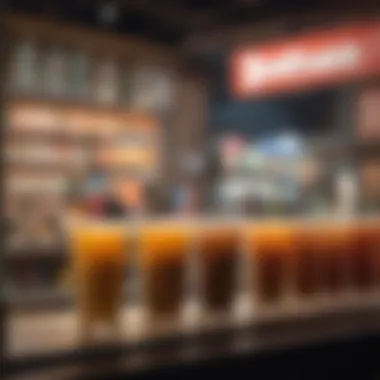The Boba Shop: A Deep Dive into Culture and Trends


Intro
The boba shop phenomenon has invaded urban landscapes across the globe, drawing in a diverse clientele eager to experience this unique drink. Originating in Taiwan during the 1980s, boba tea, also known as bubble tea, has since evolved into a multifaceted cultural icon. It is more than just a flavorful beverage—it embodies a combination of communal experience and culinary adventure.
In this article, we will explore the various aspects of boba shops, their operations, and their cultural impact. From the essential ingredients to the innovations shaping the market, each element reflects the growing popularity of boba tea. The intersection of consumer preferences and the strategies employed by boba shop entrepreneurs will be scrutinized, offering insight for both avid drinkers and prospective business owners.
Understanding this vibrant niche helps grasp the dynamics of contemporary food and beverage trends. Notably, the boba world is not without its challenges, ranging from supply chain issues to health concerns over sugar content. This exploration is designed to provide a well-rounded view of the boba tea landscape as it stands today.
Understanding Boba: The Beverage and its Origins
Boba tea, also known as bubble tea, has grown in popularity well beyond its origins in Taiwan. Understanding the beverage, its history, and its cultural impacts forms an essential foundation for exploring the boba shop industry. This knowledge helps entrepreneurs and consumers appreciate the nuances of boba, from flavor profiles to preparation methods, ensuring a deeper engagement with the product.
Historical Context of Boba Tea
Boba tea made its debut in the 1980s in Taiwan, originating from a small tea shop. The inclusion of chewy tapioca pearls transformed a traditional drink into a novel sensation. The original recipe combined tea, milk, and sugar with these pearls, creating a rich texture and an exciting taste experience. Over time, various regions developed their variations, using different teas or flavors, leading to a burgeoning global interest in the beverage.
Today, boba tea is known for its diversity. It is not limited to the original milk tea but has branched out into fruit-flavored teas, slushies, and even savory variations. This evolution is indicative of a broader trend where traditional foods adapt and integrate into modern cuisine, reflecting both local tastes and inspirations from global cuisine.
Cultural Significance in Asian Communities
Boba tea holds significant cultural meaning in many Asian communities. It is often perceived as a social drink, symbolizing gatherings and casual outings among friends and family. In cities with large Asian populations, like Los Angeles and New York, boba shops have become meeting points for various generations.
Moreover, boba tea embodies elements of innovation within tradition. Many young entrepreneurs from Asian backgrounds have used boba businesses as a platform to express their culinary creativity while preserving cultural practices. This dynamic interplay has made boba not just a beverage, but a cultural phenomenon that speaks to identity and continuity.
"Boba is more than just a drink; it is a bridge between cultures, a place of gathering, and a platform for creativity and innovation."
Understanding the journey of boba tea from its humble beginnings to its current global presence provides critical insight. The beverage stands as a testament to cultural adaptation and community, making it essential for anyone interested in the boba shop landscape.
The Structure of a Boba Shop
The structure of a boba shop plays a crucial role in its success. It encompasses various elements such as layout, equipment, and staffing. Each aspect of a boba shop’s structure must be thoughtfully designed and executed. The right structure can enhance customer experience, improve operational efficiency, and foster a unique brand identity.
Layout and Design Considerations
When designing a boba shop, the layout is one of the first and foremost considerations. An effective layout ensures smooth customer flow and enhances the overall shopping experience. Key aspects include:
- Customer Counter: The counter should be easily accessible to customers. A clear view of product offerings and preparation can entice potential customers.
- Seating Arrangement: Depending on the target demographic, seating can encourage customers to linger. Comfortable seating allows for social interaction, making the shop a preferred gathering spot.
- Aesthetic Appeal: The design should reflect the brand’s personality. This may include color schemes, decor elements, and signage that resonate with the customers. Unique designs can differentiate a shop in a crowded market.
Equipment Essentials for Operations
Operational efficiency in a boba shop relies heavily on the right equipment. Essential tools include:
- Boba Cookers: High-quality boba cookers can ensure perfect cooking and optimal texture. Consistency is key in preserving the product’s signature characteristics.
- Blenders: Powerful blenders are important for both beverages and smoothies. An efficient blending process is essential in delivering quality drinks quickly.
- Refrigeration Units: Proper storage is vital for maintaining ingredient freshness. Refrigeration units should be well-organized for quick access.
- Point-of-Sale Systems: A modern POS system streamlines transactions. It can also assist in managing inventory and tracking sales.
Staffing and Training Needs
The success of a boba shop greatly depends on its staff. Proper staffing and training are essential for efficient service and product quality. Considerations include:
- Hiring Practices: Staff should possess both customer service skills and an understanding of the product. A keen interest in boba tea can make employees more effective ambassadors of the brand.
- Training Programs: Comprehensive training should cover product knowledge, customer interaction, and operation of equipment. Continuous training keeps staff updated on new trends and offerings.
- Team Dynamics: A positive work environment encourages teamwork and enhances productivity. This can lead to better service, which in turn, can improve customer satisfaction.
"A boba shop should not just be a place to grab a drink; it should be an experience that customers look forward to visiting."
The structure of a boba shop is more than mere practicality. It encompasses the atmosphere, operational strategy, and customer engagement. Each component must work in harmony to create a memorable experience.


Diverse Product Offerings
Diverse product offerings are crucial for boba shops since they attract a broader customer base. These offerings enhance the experience of customers who visit a boba shop. The mix of flavors and accompaniments can significantly influence customer satisfaction and loyalty. Providing a variety is not just beneficial but necessary in a competitive market. Boba shops can stand out by offering both unique and traditional options to meet different tastes.
Classic and Innovative Boba Flavors
Classic boba flavors, such as taro, matcha, and brown sugar, remain perennial favorites. They serve as the foundation of boba shops, appealing to customers familiar with traditional tastes. However, to stay relevant, shops must blend innovation with cuisine. This leads to the emergence of flavors like lavender, mango-pineapple, and even savory options like cheese cream drinks. By keeping a focus on both classic and innovative flavors, boba shops can cater to various preferences. It helps establish a modern identity, attracting not just regulars but also new customers looking for novel tastes.
Accompanying Snacks and Desserts
In addition to drinks, snacks and desserts play a significant role in the overall offering of boba shops. Many customers prefer to enjoy a snack alongside their boba tea. Items such as Taiwanese popcorn chicken, mochi, or boba-themed desserts like boba ice cream and cakes can create a more rounded experience. By integrating these accompaniments, shops can enhance their menu and create more opportunities for upselling. This is essential for increasing revenue, especially as customers often view boba time as a social occasion, thus ordering multiple items.
"The right pairing of snacks with boba can elevate the overall experience and satisfaction of customers, leading to repeat visits."
In summary, diverse product offerings are essential for the success of boba shops. They create engagement and fulfill customer desires for variety. By balancing classic options with innovative flavors and providing complementary snacks and desserts, shops can thrive in a competitive environment.
Marketing and Branding Strategies
In the competitive landscape of boba shops, effective marketing and branding strategies are essential for success. A strong brand identity helps to differentiate a shop from others, creating a recognizable name among consumers. The visual and promotional elements should resonate with the target demographic, fostering loyalty and encouraging patronage. The advantages of well-executed marketing can be immense, driving not just immediate sales but also long-term growth.
Target Demographics and Consumer Behavior
Understanding target demographics is crucial for boba shops. Different age groups, cultures, and lifestyles influence preferences for flavor, presentation, and overall experience. Typically, boba tea appeals most to younger consumers, especially millennials and Generation Z, who value novelty and social sharing. Market research indicates that these groups are often looking for unique flavor combinations and visually appealing beverages.
- Age Group: Younger consumers are more explorative. They respond to trends, often sharing their experiences on social media.
- Cultural Influence: Many consumers are drawn to boba tea due to its Asian roots and cultural significance, which adds depth to their consumption experience.
By tailoring products to match these preferences, any boba shop can enhance customer engagement and maximize sales potential. A shop’s interior design, product offerings, and even staff training should reflect an understanding of these factors.
Social Media Impact on Boba Shops
Social media is a powerful tool in the marketing arsenal of boba shops. Various platforms, including Instagram, Facebook, and TikTok, serve as prime spaces for boba shops to showcase their creativity and engage directly with consumers.
The visuals associated with boba, from colorful drinks to aesthetically pleasing interiors, lend themselves well to social sharing. Positive posts and reviews can increase visibility significantly. Users are more likely to share experiences on platforms where visuals shine, creating organic advertising that is both authentic and engaging.
- Viral Trends: Boba shops can create viral marketing campaigns. Challenges or unique flavor releases that resonate can catch on quickly.
- Customer Interaction: Engaging with followers through polls, comments, and stories keeps the audience connected. This interactive approach fosters loyalty.
Overall, the impact of social media can be transformative, helping boba shops adapt to quickly changing consumer preferences and demands.
Successfully merging these marketing strategies with an understanding of consumer behavior can provide a sustainable competitive advantage in this vibrant industry.
Trends in the Boba Industry
The boba industry is evolving continuously, responding to shifts in consumer behaviors and preferences. Trends reflect not only changes in tastes but also an increased awareness around health, sustainability, and technology. Tracking these trends is essential for any boba shop aiming to remain competitive in a saturated market. By aligning offerings with current trends, shops can attract diverse customer bases while enhancing overall brand loyalty.
Health-Conscious Offerings: Low-Sugar and Plant-Based Options
As health becomes a growing concern for many consumers, boba shops are adapting their menus to cater to these changing needs. Low-sugar options and plant-based products are increasingly popular. With many patrons looking to reduce sugar consumption, boba shops now offer alternatives sweetened with natural sweeteners or sugar substitutes. These adjustments do not compromise taste but provide a healthier choice for customers.
Additionally, plant-based options, including dairy-free milk like oat or almond, have become mainstream. These alternatives attract lactose-intolerant customers or those following vegan diets. Incorporating these items into the menu can enhance customer satisfaction and broaden appeal. A boba shop must consider these trends to remain relevant to health-conscious consumers.
Seasonal Limited-Time Offers
Seasonal promotions are another critical trend within the boba industry. Limited-time offerings keep the menu fresh and enticing. These promotions often highlight seasonal ingredients or flavors, resonating with consumers’ desire for novelty. For instance, a summer-themed mango boba with tropical flavors or a fall-inspired pumpkin spice edition can draw attention in respective seasons.


These limited-time items not only encourage customers to visit again but also can create urgency to try new flavors, boosting sales. Seasonal promotions also provide excellent opportunities for marketing. By highlighting these offerings on social media, shops can engage with their audience, further increasing visibility and foot traffic.
"Adapting to trends not only improves customer experience but also primes boba shops for longevity in a changing market."
Technology and Innovation in Boba Shops
Technology plays a pivotal role in the evolution of boba shops. It enhances operational efficiency, improves customer experience, and drives business growth. As boba remains a preferred beverage globally, integrating innovative solutions is key to staying competitive. Businesses that adopt new technologies can optimize workflows, reduce wait times, and meet the demands of modern consumers effectively.
Point-of-Sale Technology
Point-of-sale (POS) technology is crucial for boba shops. This system streamlines transactions and keeps track of sales data. Modern POS systems can integrate with inventory management, allowing owners to monitor ingredient usage and manage stock levels effectively. The use of tablets or mobile devices in POS transactions also facilitates quicker service, enhancing customer satisfaction.
Although traditional register systems are still common, more shops are switching to cloud-based solutions. These systems offer remote access to sales data, enabling owners to make informed decisions from anywhere. Automated reporting functions can provide insights into peak hours and customer preferences, helping to tailor marketing strategies.
Online Ordering and Delivery Services
In today's fast-paced world, online ordering and delivery services are paramount for boba shops. In 2020, the pandemic accelerated the growth of online food delivery. Many consumers now expect to order their favorite beverages from the comfort of home.
By implementing online ordering, boba shops can expand their customer base significantly. Partnering with platforms like UberEats or DoorDash can boost visibility. Additionally, proprietary apps can allow for direct communication with customers and loyalty programs. A well-developed online system increases order efficiency and minimizes errors.
Challenges Facing Boba Shops
The boba shop industry has seen a remarkable growth in recent years. However, it is not without its challenges. This section explores the specific issues that boba shops face today. Understanding these challenges is vital for anyone looking to enter this competitive market. The importance lies not only in recognizing obstacles but also in devising strategies to overcome them. By addressing these challenges, boba shops can maintain their appeal and continue to innovate.
Supply Chain Issues and Ingredient Sourcing
One of the most pressing challenges for boba shops is managing the supply chain effectively. Many boba ingredients, such as tapioca pearls, specific teas, and flavoring agents, are sourced from various suppliers. Fluctuations in prices, shipping delays, and even global events can disrupt the availability of these essential components. This can result in limited menu options for customers and a potential decline in sales.
Ingredient sourcing is complicated furthermore by the demand for quality. Many consumers today prioritize freshness and authenticity in their food choices. Boba shops must ensure that they procure high-quality ingredients while also being cost-effective. Striking a balance between these sometimes opposing needs can be daunting.
Additionally, geographic location significantly impacts ingredient sourcing. Shops in urban areas might have access to diverse suppliers, while those in less populated regions could struggle. Those shops might need to invest more time and resources to secure fresh, quality inputs.
Market Saturation and Competition
The rapid rise in popularity of boba tea has led to a surge in the number of boba shops opening. While this is a positive trend, it also creates a crowded market. Shops often find themselves competing not only with each other but also with other beverage establishments that offer alternative drinks.
In such a saturated market, distinguishing one's brand becomes critical. Boba shops must creatively showcase their unique offerings. Whether through innovative flavors, specialized recipes, or engaging store ambiance, having a clear value proposition is essential to attract loyal customers.
Moreover, competition drives price wars. Shops may feel pressured to lower prices to remain appealing, which can affect profit margins. Maintaining quality while being competitive is a delicate balancing act. Instead of just competing on price, boba shops can consider focusing on customer experience. From personalized service to unique flavors, these measures can enhance loyalty.
The boba tea market is a vibrant field filled with potential, but only a few can truly excel without adapting to these challenges.
Boba in International Markets
The rise of boba tea, or bubble tea, in international markets reveals its growing significance beyond its Asian roots. This section looks into expansion of boba shops to Western countries and their subsequent influence on local culinary scenes. It is crucial to understand how boba tea has become more than just a beverage; it serves as a bridge connecting different cultures through unique flavor combinations and innovative business practices.
Expansion to Western Countries
The expansion of boba shops into Western countries marks a critical chapter in the beverage's history. Initially, boba tea was introduced in the late 20th century, primarily in regions with large Asian populations. Today, cities like Los Angeles, New York, and London have embraced this drink, contributing to boba’s global appeal.
Some of the key factors fueling this expansion include:
- Diverse Demographic Reach: Boba shops cater to a wide audience, appealing to teenagers and young adults who seek novel experiences in their food and drink choices.
- Customization Options: The ability to customize orders—ranging from base teas to add-ons like tapioca pearls—resonates particularly well with consumers looking for personal experiences.
- Social Media Influence: Platforms like Instagram and TikTok have amplified the visibility of boba shops, showcasing colorful drinks that attract both new customers and avid social media users.


Consequently, the boba market in the West has become competitive, with chain brands like Kung Fu Tea and Gong Cha establishing themselves alongside local shops. This competitive landscape also prompts boba entrepreneurs to innovate, experiment, and find ways to differentiate themselves.
Influence on Local Culinary Scenes
The introduction of boba tea has had a remarkable impact on local culinary scenes in various Western cities. As boba shops become commonplace, their influence extends beyond just the menu; they encourage culinary fusion and creative ingredient use.
- Fusion Food Trends: Boba tea shops often integrate local flavors or ingredients, such as matcha in Japan or seasonal fruits in summer, enhancing the local culinary palette.
- Collaborations with Local Businesses: Many boba shops partner with bakeries or dessert cafes, creating unique offerings like boba-infused pastries or desserts that highlight regional tastes.
- Culinary Events: With the rise of boba, events such as boba festivals and tastings have gained popularity. These events foster community engagement while allowing for food exploration.
"Boba has evolved from a niche beverage to a culinary sensation that resonates across different cultures. Its adaptability is key to its success in diverse markets."
As a result, boba tea shops have become integral to local food culture, continuously shaping consumer preferences and dining experiences. This symbiotic relationship between boba and the local culinary industry illustrates the beverage's dynamic role in modern societies.
Sustainability Practices in Boba Production
Sustainability is becoming an increasingly critical focus within the boba industry. As consumers become more environmentally conscious, there is a growing demand for boba shops to adopt sustainable practices. This encompasses everything from ingredient sourcing to packaging methods. By prioritizing sustainability, boba shops can not only align with consumer values but also contribute positively to the environment.
Eco-Friendly Packaging Solutions
One of the most visible aspects of sustainability in boba production relates to packaging. Traditional plastic cups and straws have come under scrutiny due to their impact on the environment. Many boba shops are now opting for eco-friendly packaging solutions. These solutions may include biodegradable cups, compostable straws, and recyclable materials.
Benefits of using eco-friendly packaging:
- Reduced Environmental Impact: Minimizing plastic waste helps protect marine life and reduces pollution.
- Customer Attraction: Many consumers prefer businesses that demonstrate concern for the environment.
- Possible Cost Savings: In some cases, sustainable packaging can lead to lower disposal costs.
While switching to eco-friendly packaging can involve higher upfront costs, the long-term benefits can significantly outweigh them. Education about the materials used can also enhance the customer's perception of the brand.
Sourcing Sustainable Ingredients
Ingredients are the backbone of any boba shop. Sourcing sustainable ingredients not only contributes to a healthier planet but also ensures product quality. Many boba shops are recognizing the importance of using ingredients that are ethically produced. This can include organic tea, locally grown fruits, and responsibly sourced tapioca balls.
Considerations for sustainable ingredient sourcing:
- Local Sourcing: Supporting local farmers reduces transportation emissions and supports the community.
- Fair Trade Practices: Ensuring that ingredients are sourced from fair trade suppliers protects farmers and their local economies.
- Organic Certification: Using organic ingredients minimizes the use of harmful pesticides, benefiting both consumers and the environment.
Overall, sourcing sustainable ingredients can enhance a boba shop's brand image, attract environmentally conscious customers, and contribute to sustainable food systems.
"Sustainability in boba production is not just good for the planet; it also resonates with a growing community of mindful consumers."
In summary, adopting sustainable practices in boba production is essential not only for environmental responsibility but also for engaging with today's conscious consumer base. Boba shops that embrace these practices set themselves apart in a saturated market, paving the way for long-term success.
The Future of Boba Shops
The boba shop industry is in a constant state of evolution, adapting to shifting consumer preferences and emerging trends. Understanding the future of boba shops is essential for entrepreneurs and investors alike. It provides insights into how businesses can not only survive but thrive in this competitive space. The vitality of this market lies in its ability to blend traditional practices with modern innovations, which will shape the operational landscape of boba shops in the coming years.
Emerging Trends in Consumer Preferences
Consumer preferences play a significant role in determining the trajectory of boba shops. Today’s customers are more health-conscious than before. They seek beverages that not only satisfy their taste but also align with their dietary goals. Here are some key trends:
- Healthier alternatives: There is a noticeable shift towards low-sugar and low-calorie options. Many boba shops are responding to this demand by introducing sugar-free syrups and plant-based alternatives. Almond milk and oat milk are becoming increasingly popular bases.
- Customization: Consumers enjoy personalizing their drinks to suit their unique tastes. Offering various levels of sweetness, toppings, and flavors is no longer an option but a necessity for boba shops.
- Sustainability Concerns: With a growing awareness of environmental issues, customers look for brands that prioritize sustainability. This includes eco-friendly packaging and sourcing of ingredients. Boba shops that implement sustainable practices often gain customer loyalty.
"The future of consumer habits indicates that innovation must be matched with ethical practices to initiate long-term growth in the boba industry."
The influence of social media cannot be overlooked. Platforms such as Instagram and TikTok play a pivotal role in shaping consumer preferences. Visually appealing drinks often go viral, which can significantly boost a boba shop’s foot traffic.
Potential for Business Growth and Adaptation
The potential for business growth in the boba industry remains substantial. Several factors contribute to this positive outlook:
- Expanding Market Reach: New locations and franchising opportunities can lead to increased brand visibility. As boba tea grows in popularity beyond Asian communities, reaching a broader demographic can enhance profits.
- Collaborations and Partnerships: Boba shops that collaborate with other local businesses can create unique offerings that attract new customers. For example, a partnership with dessert shops can result in exclusive boba-infused desserts.
- Evolving Technology: Incorporating technology improves customer experience. Utilizing apps for online ordering and payments can streamline operations and engage customers effectively.
Growth also requires flexibility. Boba shops that remain adaptable to market changes can leverage new trends quickly. Businesses that revisit their menus frequently and innovate their offerings will more likely meet evolving consumer demands.







